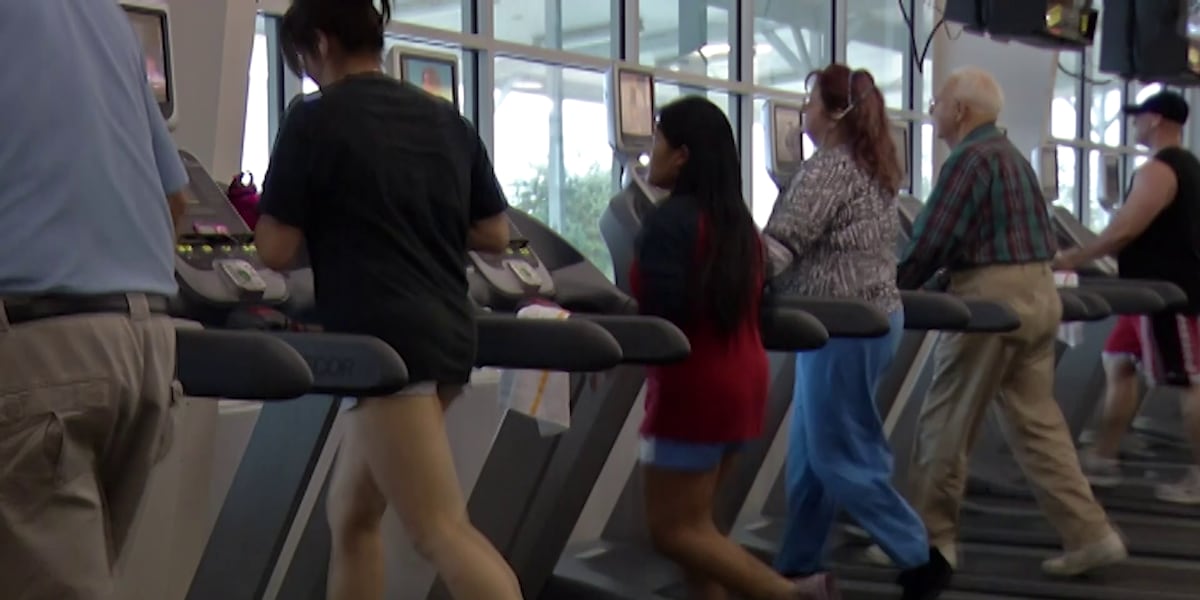Fitness
A 69-Year-Old Fitness Trainer Shares the 6 Exercises That Keep Her Looking Half Her Age
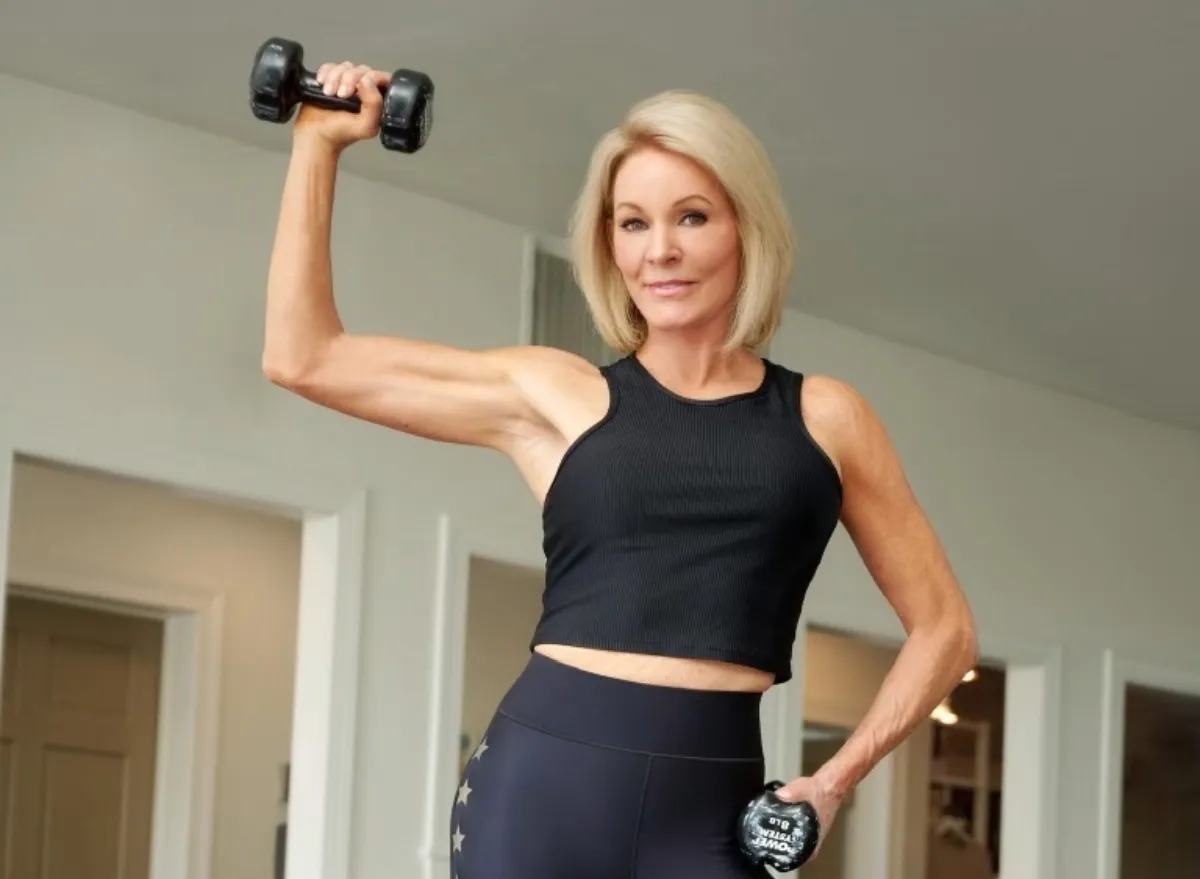
Aging gracefully requires following a well-rounded routine, complete with a healthy diet and regular exercise. You may think that getting older means it’s too late to kickstart a fitness routine, but that’s simply not the case. “It’s never too late to begin exercising,” stresses 69-year-old fitness trainer Liz Hilliard, the creator and owner of Hilliard Studio Method. “As a matter of fact, it’s a requirement for healthy aging of your body and mind. Both are inseparable when it comes to the benefits of exercise.” Hilliard shares with Eat This, Not That! a couple of her go-to fitness tips, along with the best exercises she recommends for healthy aging.
“My top fitness tips can be summed up in one word: MOVEMENT. As in, do not stop moving,” Hilliard tells us. Her two pro tips include walking every day, anywhere you can. “Get outside as often as possible to walk in nature,” she says. “Bonus points if you walk with a friend. It’s built-in mental and physical therapy which will not only help keep you fit but keep your mood lifted and mind creative.”
In addition, strength training four times a week is crucial. “Strength training is an absolute requirement for healthy aging and simply means load-bearing exercises that require your muscles to engage,” Hilliard explains. “This can include anything from hand weights, resistance bands, weighted balls, or any weighted object that taxes and builds skeletal muscles. Skeletal muscle strength allows the body to burn calories and maintain a healthy weight while setting the body up for success when inevitable accidents happen, so you are far less likely to avoid falling and breaking bones.”
Now that you know carving out time for cardio and strength training is key, read on to learn all about Hilliard’s go-to exercises for healthy aging. “All of these exercises are Pilates-based and low-impact to increase your strength while maintaining a healthy cardiovascular level,” Hilliard says. When you’re finished reading, be sure to check out A 69-Year-Old Trainer Shares the 7 Fitness Habits That Keep Her Looking 25.
Planks
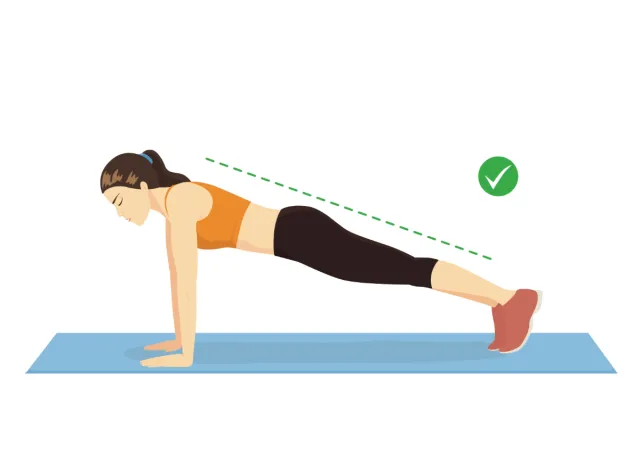
The plank is a classic exercise that’s known to strengthen your entire core, resulting in improved spine strength and flatter abs. This move can be performed on your forearms (your elbows placed under your shoulders) or with straight arms (your hands placed below your shoulders). Be sure to engage your core the entire time you hold the position.
Pushups
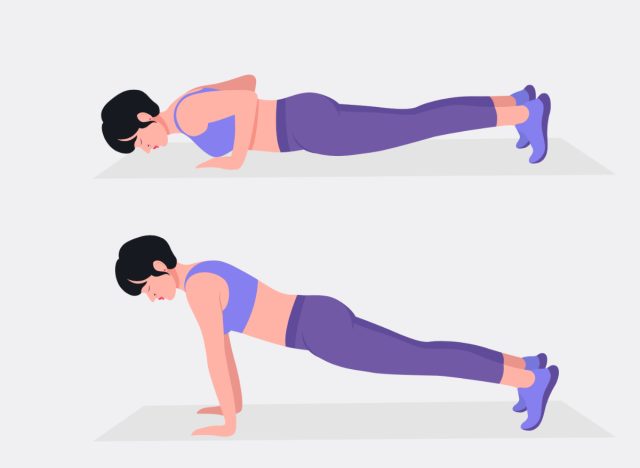

The pushup is another exercise that puts your body’s strength to the test. You can complete pushups with your legs straight or your knees on the ground.
“Never done a pushup? Begin by leaning against a wall at an angle with your hands slightly wider than your chest,” Hilliard suggests. “Bend your elbows, taking your chest to elbow level to protect your shoulders while simultaneously strengthening them. A pushup is simply a moving plank that engages your core muscles and strengthens your upper body and back as well.”
Bicep Curls with Squats
You can perform bicep curls with squats by using resistance bands or light hand weights. Begin by standing tall with your core activated. Then, bend both knees while pressing your hips back as if you’re about to sit in a chair. Bend your elbows to perform a bicep curl as you press back up to standing.
Rows
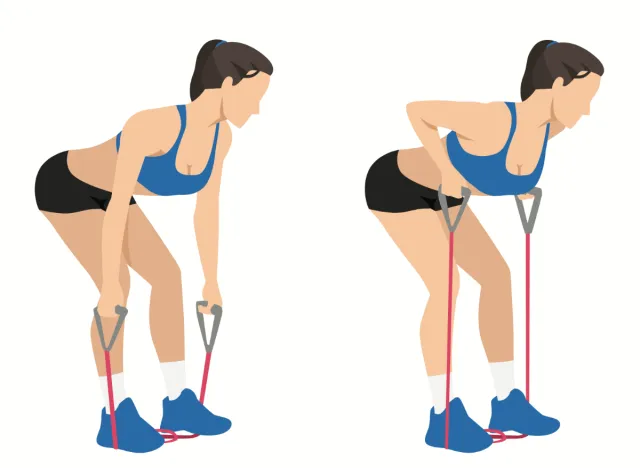

Rows are another exercise that can be completed with resistance bands or hand weights. “Stand with [your] core connected, hinging your body at the waist forward with weights or resistance bands in hand, then rowing from straight arms low to high by bending your elbows close to your side waist feeling the back muscles engage and strengthen,” Hilliard instructs.
If you’re working with resistance bands, stand evenly on top of them, and hold each end in your hands so you’re able to control the amount of resistance used.
Triceps Dips
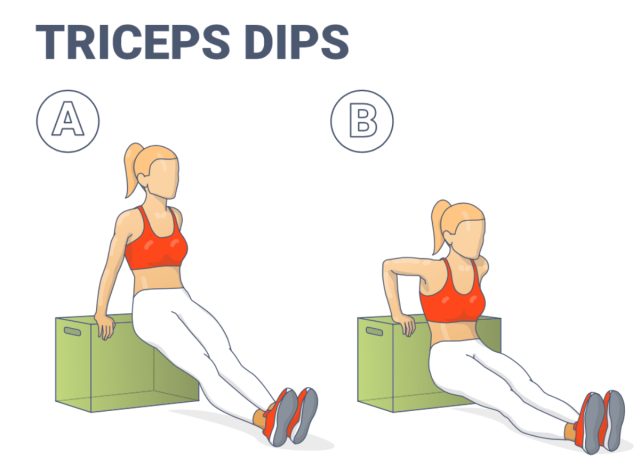

This exercise uses gravity as resistance. Begin by sitting on the ground with your hands facing forward and placed just behind you. Activate your core to lift your buttocks off the ground, then bend and extend your elbows eight to 12 times to sculpt and strengthen your triceps. You can also do this exercise with your hands planted at the edge of the chair, workout bench, or a stable surface, with bent knees and your feet flat on the floor.
Hip Lifts
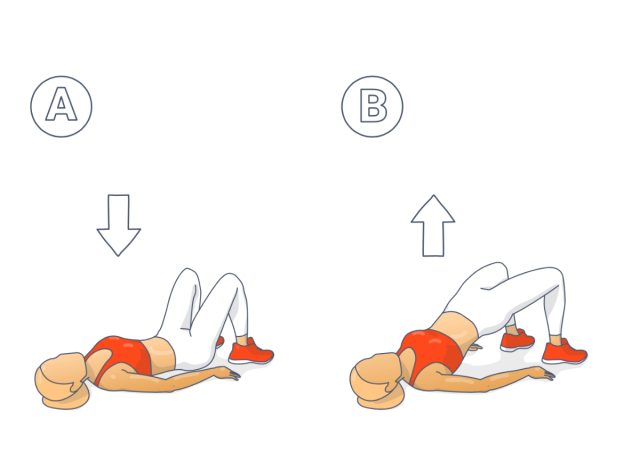

Last but not least, it’s time to work the hamstrings with hip lifts. “Lie flat on the floor with [your] knees bent and [your] feet under your knees,” Hilliard instructs. “Engage your core with a slight pelvic tilt to lift your hips off the ground. Keeping your head and shoulders on the ground, lower and lift your hips eight to 12 times. Then, [hold] at the top, and do eight to 12 gentle tucks of the hips to fully engage the back of the legs and buttocks. To advance this hamstring exercise, lift one leg in the air keeping your hips level to focus on one leg at a time.”
Alexa Mellardo

Fitness
Can a

Exercising regularly is important for preventing dementia. But if it’s hard to rack up the recommended amount of activity during the five-day work week (150 minutes of moderate-intensity activity, like brisk walking, or 75 minutes of vigorous activity, like swimming), consider the “weekend warrior” approach — fitting it all into one or two weekly sessions. The approach might offer the same brain health benefits, according to a study published online Oct. 29, 2024, by the British Journal of Sports Medicine. Researchers analyzed the health and self-reported activity information of more than 10,000 dementia-free people in Mexico who were followed for about 16 years. After accounting for factors that could influence the results, such as lifestyle habits, scientists found that weekend warriors were 13% less likely to develop mild cognitive impairment (MCI), a precursor to dementia, compared with people who didn’t exercise — about the same benefit seen in those who exercised during the work week. While the study was observational and can’t prove cause and effect, it supports the idea that even less frequent exercise might help protect brain health, and it might be a more convenient option for busy people.
Image: © Luis Alvarez/Getty Images
As a service to our readers, Harvard Health Publishing provides access to our library of archived content. Please note the date of last review or update on all articles.
No content on this site, regardless of date, should ever be used as a substitute for direct medical advice from your doctor or other qualified clinician.
Fitness
Fitness face-off – Harvard Health

What’s in style? The question doesn’t just relate to fashion. Indeed, even exercise styles go in and out of vogue, echoing trends fueled by social media and other cultural drivers.
Case in point: high-intensity bursts of exercise have grabbed headlines over the past couple of years, with scientists generating an array of studies examining the health benefits of short spurts of movement lasting from one to three minutes. That might consist of jumping jacks, lunges, running in place, jumping rope, air boxing, running up stairs, or any other high-intensity activity.
Meanwhile, plenty of research continues to focus on the health advantages of moderate-intensity, continuous movement. Mainstay choices for these sessions include brisk walking, cycling, jogging, and elliptical and treadmill use.
Given the swings in popularity between the differently paced alternatives, perhaps the most pressing question is which one is better for us. It might seem certain exercise patterns might prove superior to others, but we should resist the temptation to believe that, says Dr. Meagan Wasfy, a sports cardiologist at Harvard-affiliated Massachusetts General Hospital.
“There are always trends, and each one claims to be the latest and best way to move your body,” Dr. Wasfy says.
Breaking down the data
What health benefits does each approach offer? A sampling of recent studies and official health guidance weighs in.
Evidence supporting exercise bursts includes the following:
- A 2022 analysis of data collected on more than 25,200 people who didn’t otherwise exercise (average age 62, 56% women) published in Nature Medicine found that those who routinely did brief bursts of vigorous activity — defined as three bouts, each lasting a minute or two — had significantly lower odds of dying or developing cardiovascular disease over the following seven years than participants who didn’t.
- A 2023 analysis in JAMA Oncology of more than 22,000 people who didn’t exercise (average age 62, 55% women) suggested that even short, intermittent periods of intense movement — a minute at a time, three or four times a day — was linked with 18% lower cancer risk over the following 6.7 years, especially for cancers of the breast, uterus, or colon.
Evidence supporting longer, moderate-intensity exercise includes the following:
- Adults who do any amount of moderate-to-vigorous exercise derive health benefits, including reducing their risks of cardiovascular disease, diabetes, and some forms of cancer, according to the CDC.
- A 2022 analysis in JAMA Internal Medicine involving 78,000 people (average age 61, 55% women) found their risk of heart disease, cancer, and premature death dropped by 10% over the following seven years for every 2,000 steps they logged each day, with the benefit peaking at 10,000 steps.
Sense a theme from the findings? Regardless of intensity, it’s apparent that any movement is good for your health.
“No one comes out ahead with regards to the long-term outcomes,” Dr. Wasfy says. “What matters most is moving your body and doing more of it. The sum of movement, over the course of a year or decades of your life, is what matters.”
Exercise caveats
One clear advantage to exercise bursts — or its cousin, high-intensity interval training (HIIT) — is that any high-intensity activity enables you to fulfill recommended exercise guidelines in less time. Health organizations advise adults to get at least 150 minutes of moderate exercise or 75 minutes of vigorous exercise (or some equivalent combination of the two) per week. For an HIIT workout, you alternate vigorous, short sprints with brief periods of rest or lower-intensity movement.
“It’s a time-efficient way to get your recommended exercise dose in less time,” Dr. Wasfy says.
High-intensity exercise does pose a few drawbacks, however. These include a greater risk of injuries and inflammation to joints and muscles. Additionally, for people with heart disease or its risk factors, sudden bursts of exercise could be more likely to bring on new cardiac symptoms.
“If you’re writing an exercise prescription not knowing anything about someone’s health history, you’d write it for moderate-intensity, continuous exercise,” Dr. Wasfy says.
If you’d like to increase your exercise intensity but have existing heart disease — or symptoms such as chest pain with vigorous movement — talk to your doctor in advance. Older adults who’ve noticed their ability to exercise has declined should also speak up.
Ultimately, Dr. Wasfy says, you should choose a style of exercise you really like — and will do consistently — and disregard fitness trends. “If you’re healthy,” she says, “it’s really your choice.”
Image: © Luis Alvarez/Getty Images
Fitness
Amitabh Bachchan’s diet and workout routine for staying fit at 82: Pranayam, yoga stretches, gooseberry juice and more

Amitabh Bachchan is a living legend whose popularity surpasses that of his contemporaries. At 82, his unmatched energy and commitment to fitness continue to inspire generations. Despite facing severe health challenges like tuberculosis, his disciplined lifestyle has helped him stand tall and active in the industry. Curious to know the secret behind his fitness? Let’s dive into the insights of Amitabh Bachchan’s diet plan and workout routine. (Also read: Sonu Sood shares his diet and fitness secrets for toned body at 51: ‘I’ve never tasted non-veg and I don’t drink’ )
How Amitabh Bachchan stays fit at 82
Earlier, in an interview with Humans of Bombay, Amitabh Bachchan’s wellness trainer Vrindaa Mehta revealed the actor’s unwavering dedication to fitness. She shared, “If Amitabh Bachchan can make time to exercise, normal people can too. The mindset is, when you know something is good for you, you just do it. It’s not about comfort, it’s not about not having time… If Mr. Bachchan can make time to exercise, regular people can of course, take out time to exercise.”
Talking about his fitness routine, Vrindaa added, “My sessions with Amit ji are more about breath work. We start off with basic breath exercises and move on to pranayams, and basic yoga stretches. Mindset… He’s the father of it all.”
Wellness trainer Shivohaam, who also works with Amitabh, highlighted the actor’s remarkable commitment to fitness. “There are times when we have to tell him, ‘Let’s not train right now, it’s not ideal for you.’ The point is, he does take out the time, whether it’s morning, afternoon, or evening, or even between meetings because he knows it’s important,” shared Shivohaam.
Amitabh Bachchan’s diet secrets
Amitabh Bachchan’s diet revolves around discipline and variety. In one of his blog posts, the veteran actor shared that he begins his day with tulsi leaves, followed by a breakfast featuring items like protein shakes, almonds, porridge, or coconut water. Other favourites include gooseberry juice and dates, providing a power-packed start to his mornings with a mix of healthy nuts and proteins.
When discussing his eating habits, Big B revealed, “In my youth, I would eat, but now I have left eating non-veg dishes, sweet items, rice, and won’t speak any further.” Skipping desserts and limiting sugar intake have been significant lifestyle changes that help him maintain his fitness and avoid risks like obesity.
-
/cdn.vox-cdn.com/uploads/chorus_asset/file/25822586/STK169_ZUCKERBERG_MAGA_STKS491_CVIRGINIA_A.jpg)
/cdn.vox-cdn.com/uploads/chorus_asset/file/25822586/STK169_ZUCKERBERG_MAGA_STKS491_CVIRGINIA_A.jpg) Technology1 week ago
Technology1 week agoMeta is highlighting a splintering global approach to online speech
-

 Science1 week ago
Science1 week agoMetro will offer free rides in L.A. through Sunday due to fires
-
/cdn.vox-cdn.com/uploads/chorus_asset/file/23935558/acastro_STK103__01.jpg)
/cdn.vox-cdn.com/uploads/chorus_asset/file/23935558/acastro_STK103__01.jpg) Technology1 week ago
Technology1 week agoAmazon Prime will shut down its clothing try-on program
-

 News1 week ago
News1 week agoMapping the Damage From the Palisades Fire
-
/cdn.vox-cdn.com/uploads/chorus_asset/file/25826211/lorealcellbioprint.jpg)
/cdn.vox-cdn.com/uploads/chorus_asset/file/25826211/lorealcellbioprint.jpg) Technology7 days ago
Technology7 days agoL’Oréal’s new skincare gadget told me I should try retinol
-
/cdn.vox-cdn.com/uploads/chorus_asset/file/25832751/2192581677.jpg)
/cdn.vox-cdn.com/uploads/chorus_asset/file/25832751/2192581677.jpg) Technology4 days ago
Technology4 days agoSuper Bowl LIX will stream for free on Tubi
-

 Business5 days ago
Business5 days agoWhy TikTok Users Are Downloading ‘Red Note,’ the Chinese App
-
/cdn.vox-cdn.com/uploads/chorus_asset/file/25835602/Switch_DonkeyKongCountryReturnsHD_scrn_19.png)
/cdn.vox-cdn.com/uploads/chorus_asset/file/25835602/Switch_DonkeyKongCountryReturnsHD_scrn_19.png) Technology2 days ago
Technology2 days agoNintendo omits original Donkey Kong Country Returns team from the remaster’s credits


